Great Danish Designers 101: Poul Hundevad
Danish designers from the mid-century period were often inspired by the past, looking not only to their long tradition of exceptional carpentry and cabinetmaking, but also to the designs of other time periods. They recognized quality and good design and would frequently revive or reinterpret furniture from long ago. In the case of Poul Hundevad, it was an item from the very distant past that led to his biggest success.
Poul Hundevad: Combining Past Traditions with Modern Practicality
Poul Hundevad was born in Vamdrup, Denmark in 1917. He trained as a carpenter and, for a time, owned his own cabinetmaking shop and furniture factory. In 1960, he began production of his most famous work, the Guldhøj chair. The design was a direct copy of a folding chair found in a burial mound in Vamdrup that dated back to the Scandinavian Bronze Age. It was the oldest preserved piece of furniture in Scandinavia. (http://bit.ly/1Ql6k0p)
Hundevad measured the original chair, streamlined the design, and put it into production, using four different types of wood and leather seating in light and dark shades. The chair was an immediate success and was sold around the world. According to some sources, it continued to be produced into the early 2000s. (http://bit.ly/23chj1r, http://bit.ly/1Ql6k0p)
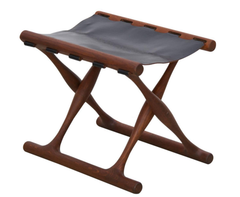
Image from 1stdibs. http://bit.ly/1nvzJK4
As a trained cabinetmaker, Hundevad made more than just folding chairs. He was also recognized for his dining chairs, tray carts, sideboards, and bookcases.
Like his contemporaries, he was an expert craftsman. Bradley Quinn notes in Scandinavian Style that this legacy dates back to the Vikings who were “world leaders” in their ingenious methods of tooling wood; techniques that enabled them to “transform several separate pieces into a single entity.” Danish designers of the mid-century were particularly well known for their exceptional joining techniques. A chair from Hundevad provides an example. The backrest flows almost seamlessly into its supports, creating clean lines and a sense of one piece flowing into the other:
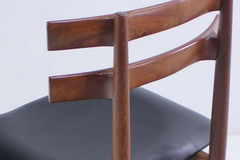
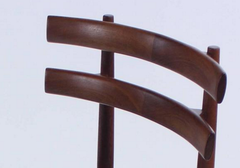
Images from 1stdibs http://bit.ly/1RxViGl
Hundevad’s gorgeous “Egyptian Chairs” offers another example. With the contours of the wood, it is hard to tell where one piece starts and the other ends. The lines of the Egyptian Chair are exactly what author Elizabeth Wilhide described when she wrote that Danish joining techniques allowed “separate members such as backs, arms and legs to read as a single, fluid whole.”

Images from 1stdibs http://bit.ly/1PEZ22X
Coming of age as a designer in the mid-century period meant that Hundevad was also concerned about functionality and flexibility in his designs. Multi-purpose furniture was all the rage in the mid-century period, a trend whose roots lie in the Scandinavian heritage of small, efficient homes that required adaptable furniture. VHB has had some wonderful pieces from Hundevad that show his practical side.
This teak dining table, now sold, included draw leaves to provide more seating, and a reversible top: the wood side was for dining; the leather side was ideal for a game of cards.
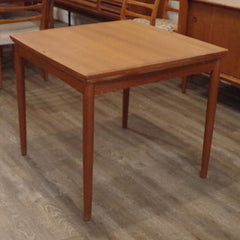
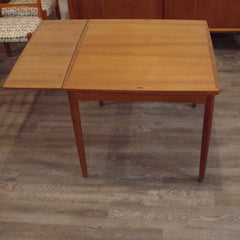

In addition to spaces for play, Hundevad incorporated spaces for work in his designs. This teak cabinet includes a drop down desk surface, movable shelves in the bookcase, and, in the bottom section, locking doors that hide four drawers and two movable shelves. This is another piece sold from the VHB collection.
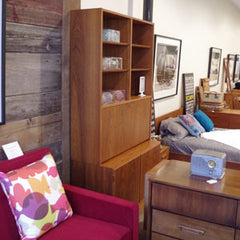

Functionality abounds in this sideboard from VHB’s past collections. Looking at the sleek exterior, you would never guess what lay behind its disappearing sliding doors: vertical storage, adjustable shelves, and a pull-out shelf.

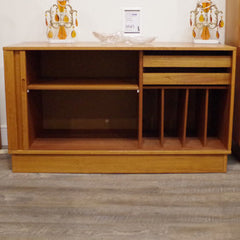
Hundevad’s transformable trolley carts offer another example of ingenious design. The top slides to one side to make room for the bottom tray, doubling the space for serving.

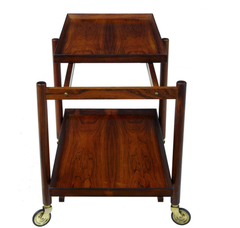

The trolley cart, dating from 1960, was one of many items Hundevad made in rosewood. While teak is most commonly associated with Danish mid-century furniture, many designers used other woods as well. Hundevad was no exception. He worked frequently with teak but also used beech, oak, and other tropical hardwoods in his furniture. He even designed his famous Guldhøj chair in oak, teak, wenge, and rosewood. Many of his bookcases were also done in rosewood, including two from VHB’s current collection, shown below.
This bookcase has the small footprint desired by homeowners in the mid-century period and now. Narrow and shallow, this piece follows the Danish design aesthetic of practicality and efficiency, offering storage without taking up too much space:
Also in rosewood, this bookshelf and matching media cabinet provide flexible storage for small spaces. In a unique design twist, the shelves include a recessed, angular edge on the front, adding visual interest and a sleek appearance:
Poul Hundevad was a quintessential Danish furniture designer. He looked to the past, stayed true to traditional craftsmanship and techniques, yet created pieces that were thoroughly modern.
The next designer in our series: Finn Juhl, architect and self-taught furniture designer.
Read more in this series: Johannes Andersen, Kai Kristiansen, and Poul Cadovius.




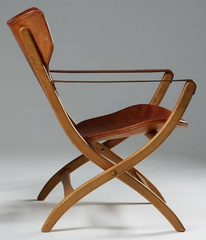

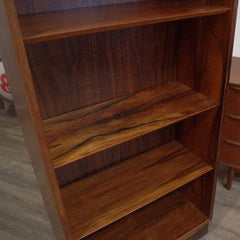
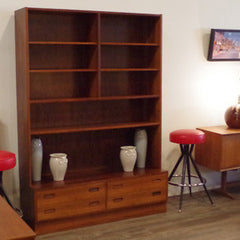
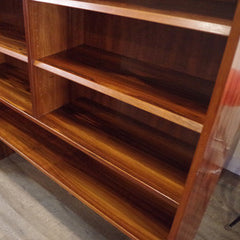
So so wonderful to read about my father Poul Hundevad. Being a designer myself I have learned so much from him
Leave a comment